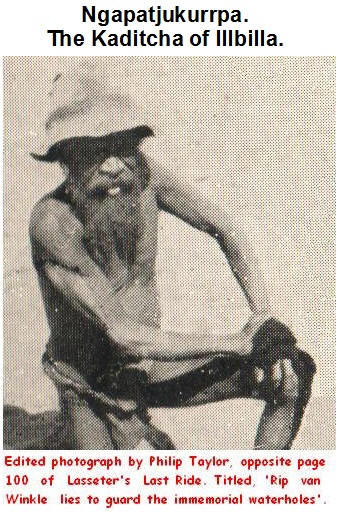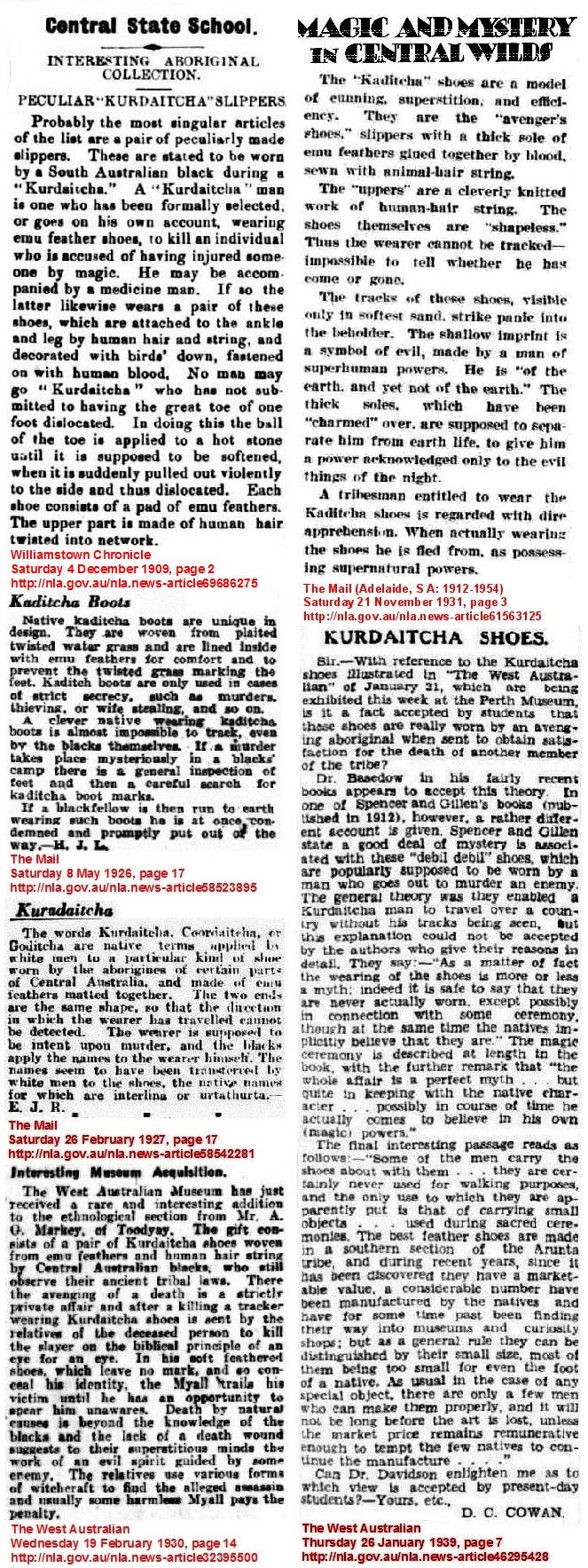138a. KADITCHA. |
|||
| "Kaditcha is the Centralian aboriginal word of terror. It conjures up stark fear; it means a terror above ordinary physical fear". | |||
|
Ion Idriess, Lasseter's Last Ride. pg 29. |
|||
|
An Arrente Aboriginal word written many ways, but universally taken to mean assassin, executioner or avenger, as with 'Pointing the Bone', there has been some extraordinary nonsense written about the Kaditcha, who are real enough, but nothing more or less than sanctioned or appointed killers. Greatly feared nevertheless for the inevitable outcome of their mission and the dark arts allegedly practised when dispatching the victim. Kaditcha are not evil spirits, ghosts or hoodoos as Idriess would have us believe, these malignant entities are known as mamu in much of Lasseter Country. A Kaditcha is a very earthly being, still subject to the whims of a mamu, or more likely, the victim of an avenging Kaditcha. In the usual circumstances a Kaditcha is appointed by a council of Elders to punish by death a transgressor of tribal law, an executioner. He is always an appropriately initiated male and may be accompanied by one or two others and is relentless in pursuit, taking years if necessary to run down a marked man, it is said that no one escapes a Kaditcha. The method of execution is seemingly consistent and straightforward, the lawbreaker is sung and boned and that alone is sufficient for the desired result, more often than not the victim is clubbed or speared until dead. Meting out punishment for breaking certain tribal laws is a prosaic business without ceremony, a Kaditcha leaves the scene immediately knowing full well that his actions may give cause for revenge....at the hands of a Kaditcha. Of course it may suit the purpose of a Kaditcha to be suspected of supernatural powers and evil ways, adding another layer of fearful anticipation to the victims numbered days and weakening his psychological defences to mute or frozen acceptance when confronted by his Kaditcha. The dark mystery of the Kaditcha certainly gave Idriess ample scope to delve into the occult, a subject of especial interest to him, there are more than a dozen references to Kaditcha in Lasseter's Last Ride, and he suggests that a Kaditcha may have been the creator of the Hoodoos that dogged the First C.A.G.E. Expedition and caused Lasseter's death. Idriess introduced the Kaditcha early in the Expeditions journey to Illbilla, on the 4th of August 1930 somewhere between Warren Creek and Mount Udor, Micky the Aboriginal guide was confronted by a Kaditcha, a lone tree on a sandhill. With a great deal of coaxing Micky reluctantly informed the men that the tree was the spirit abode of a long dead but still powerful witch doctor, the vicinity of the tree was very dangerous ground. Idriess elaborates, "Kaditcha may be represented by a sacred emblem, by the meaning in a word, a belief ~ a menace unfightable, a spirit power which by malign influence can be used against man." Idriess has broadened the meaning to include the denizens of the spirit world and their earthly symbols and totems, the lone tree that spooked Micky would be a mamu and the witch doctor may have been a Kaditcha in past life. Although he had returned to Archie Giles station a fortnight earlier, Idriess continues to torture Micky with Kaditcha when the hapless guide finds the barely discernable but distinctive tracks of a Kaditcha at Illbilla waterhole, he returned to camp in a terrified state, "Man in Kaditcha shoes he walk about! We go away quick feller!". Lasseter was remarkably conversant when answering Philip Taylors questions about Kaditcha shoes," They're shoes, explained Lasseter, of emu feathers clotted together with blood. The shoes are so made that their imprint gives no indication whether the wearer is coming or going. Thus, a foe cannot track him". Idriess makes the connection, it is the shoes that give the pedestrian Kaditcha entre to the netherworld, "The power necessary to wear the shoes is given the Kaditcha man by the spirits of the dead". Later that day and evening (16/09/30) the remaining members of the Expedition were given gifts by a band of Aboriginals that had recently arrived at the waterhole. Blakeley received a churinga, Sutherland a stone knife and Taylor a kulpidji. The men did not realise the significance of Taylors artefact until they returned to Alice Springs where an Aboriginal, "Educated at one of the best South Australian schools" informed them that the Kaditcha tracks Micky had seen belonged to Rip van Winkle (correctly named Ngapatjukurrpa) and the rightful owner of the kulpidji, a sandhill god bearing a great curse, Lasseter would not return from his journey because he touched the kulpidji first and the curse was now on Taylor's hands.
In late December 1930 Lasseter's camels bolted leaving him stranded and relying on the Aboriginals for sustenance, and always in a dangerous position according to Idriess, his only weapon a revolver and a pocketful of ammunition. To enhance his stocks and arsenal Lasseter made a great show of talking to the weapon and listening to the clicking cylinder, "He patted the revolver, hissed Kaditcha!" this had the desired effect, for the time being. In due course the tribes sorcerer challenged Lasseter's Kaditcha, a test of wills when blaming the tribes near starvation, in the Desert of the Yams, on the evil thing hanging off Lasseter's belt. Lasseter passed the test in an imaginative fashion, at the point where the challenge was likely to become deadly a sick camel arrived on the scene and was soon dispatched. Lasseter's Kaditcha was powerful indeed, it was the drawn revolver that lured the camel to the starving tribe. Philip Taylor was involved in a Kaditcha incident at Illbilla on the 21st of December, the day after the expected arrival of Pittendrigh and Hamre, "There was a Gerditcha (kurdaitja) scare in the native's camp last night, they declared the devil was about, & we had to fire guns to scare him away", later in his diary Taylor mentions drafting the opening lines to a story about 'Geditcha' that he hoped to finish on the return voyage to England where he arrived the following year. He went on to lead a full and adventurous life, entirely untroubled by Geditcha, mamu and any curses lurking in Ngapatjukurrpa's kulpidji. Idriess writes a great deal about Kaditcha and their familiars in Lasseter's Last Ride, yet the word is not mentioned in the index. Coote and Blakeley make no reference to Kaditcha in their narratives on the First C.A.G.E. Expedition. As for Kaditcha shoes, they are purely ceremonial and perhaps more significant for that, in the Harts Range where the practise was first noted a pair of shoes would last perhaps a kilometre on the hunt with a trail of emu feathers a little further. Micky had returned to Archie Giles station on 31/8/1930, Lasseter and Johns left Illbilla the day before the gift giving ceremony where Taylor received Ngapatjukurrpa's supposedly cursed kulpidji. Blakeley confirms that Lasseter and Johns had already left Illbilla, "so did not have the god-stick blessing or otherwise as many people believe". The word appears as kadaicha in that excellent volume compiled by Cliff Goddard, the Pitjantjatjara/Yankunytjatjara to English Dictionary at pages 33, 150 and 232. The reference is an example of an Arrente word subsuming the Pitjantjatjara. In the Petermann Ranges, Lasseter’s tormentor, Old Bones, would be a, tjina karpilpa, broadly meaning, ‘feather bound foot’, “tjina karpilpa, kadaicha man, magician-assassin. So called because of his characteristic emu-feather shoes”. Hence the occasional name 'featherfoot'.
© R.Ross. 1999-2006 |
|||
| Fred Blakely, Dream Millions. pg. 166. Ion Idriess, Lasseter's Last Ride. pgs. 28-30,71,72,90-92,132,139,212-215,223,226,230. Charles P. Mountford, Brown Men and Red Sand. pgs. 89-91. A. P. Elkin, The Australian Aborigines. pgs. 313-316. Camel Treks in the Outback, P. A. Scherer. pgs. 39,41. | |||
|

